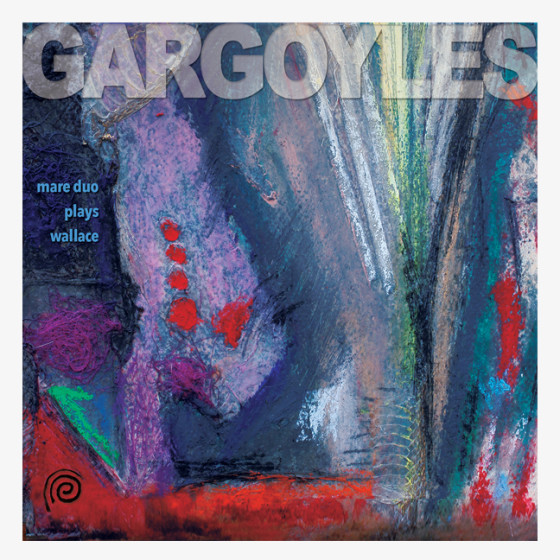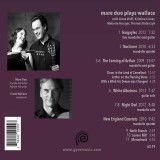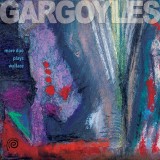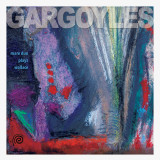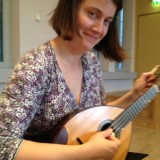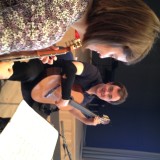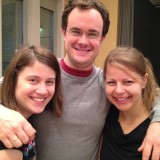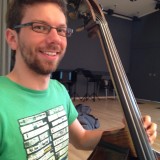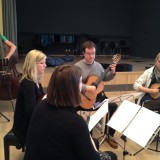GARGOYLES CD | Mare Duo plays Wallace
Mare Duo & Friends
play mandolin/guitar works of Frank Wallace
GYRE 10202 | UPC 802442102027
SUGGESTED DONATION: $15 for CD (includes shipping); $12 for Hi-Res 24-bit .wav files: $8 for MP3s; DOWNLOAD BUTTON WILL GIVE YOU THE MP3s. Please specify if you want a different format with a message through our CONTACT PAGE. Hi-res files or CD will be sent then.
“…quite astonishing…an exquisite canvas…palpable excitement…consummate skill…virtuoso playing.”
Canfield, Fanfare Nov/Dec 2014
Available at Strings by Mail
Performers: Annika Hinsche, mandolin I; Fabian Hinsche, guitar; Anne Wolf, mandolin II (track 1); Kristina Lisner, mandola (track 2,9,10,11); Melanie Hunger, mandolin II (track 2,9,10,11); Thomas Kolarczyk, contra bass (track 2)
Download Complete Notes: Program Notes for Gargoyles CD
Recorded: August 2012 at the Wuppertal Conservatory of Music, Germany; Night Owl September 2013 at the Hillsborough Center Congregational Church, NH; and White Albatross December 2013 at Klangport Musikproduktion in Heek, Germany
Released: May 15, 2014
Duration: 63:19
Microphones: Schoepps omnis and Neumann U87 through an Orpheus interface
Engineering and mastering: Frank Wallace, except White Albatross recorded by Matthias Reuland
Artwork and design: Nancy Knowles;
Photographs – back cover: Bettina Osswald (duo), Nancy Knowles (FW); interior: Frank Wallace
All Gyre compositions are ASCAP
Copyright ©2014 Frank A. Wallace
Cover photography and design by Nancy Knowles
All rights reserved.
Tweet
01) Gargoyles (2012) 7:32
for 2 mandolins and guitar, op. 68
Annika Hinsche, mandolin I; Fabian Hinsche, guitar; Anne Wolf, mandolin II
02) Nocturne (2010) 6:23
for mandolin orchestra, op. 62
Annika Hinsche, mandolin I; Fabian Hinsche, guitar; Kristina Lisner, mandola; Melanie Hunger, mandolin II; Thomas Kolarczyk, contra bass
The Coming of Arthur (2009)
for mandolin and guitar , op. 53
Annika Hinsche, mandolin; Fabian Hinsche, guitar
03) Chaos in the Land of Cameliard, 12:47
04) Arthur on the Flaming Wave, 3:52
05) With a Wink his Dream was Changed, 6:28
06) White Albatross (2013) 7:47
for guitar solo, op. 79
07-8) Night Owl (2012) 8:48
for mandolin solo, op. 73
Annika Hinsche, mandolin
New England Quartets (2010)
for mandolin orchestra in five parts; or quartet without bass, op. 60c
Annika Hinsche, mandolin I; Fabian Hinsche, guitar; Kristina Lisner, mandola; Melanie Hunger, mandolin II
09) North Branch 2:59
10) Loveren Mill 1:48
11) Monadnock 4:55
TOTAL TIME: 63:19
BIOGRAPHIES
 Annika Hinsche, maiden name Lückebergfeld, was born in Bielefeld/Germany in 1981 and is one of the most successful German mandolinists. She is prizewinner on several national and international competitions, e.g. reknowned “Yasuo-Kuwahara-Competition“, and performs throughout Europe, Asia and USA. She teaches as assistant professor at “Cologne University of Music and Dance, Wuppertal Campus“, as tutor in highly awarded “JZO NRW“ and on international festivals in whole Europe and USA. Her students are prizewinners on different international competitions. Annika released several CD’s, e.g. her Solo-CD “Aproximação“, “Mare Duo“ CD “Crystal tears“ or “Impressioni“ with “Quartetto Colori“. Moreover, she regularly conducts representative and festival orchestras in several countries in Europe. She is dedicatee of numerous compositions by well-known composers. She edited music for several publications with different publishing houses, e.g. in “edition mare duo“ with Trekel/Hamburg. A. Hinsche studied mandolin with Prof. M. Wilden-Hüsgen, Prof. C. Lichtenberg, Prof. J. McGann and G. Weyhofen-Tröster. More information: www.annika-hinsche.de or www.mareduo.com
Annika Hinsche, maiden name Lückebergfeld, was born in Bielefeld/Germany in 1981 and is one of the most successful German mandolinists. She is prizewinner on several national and international competitions, e.g. reknowned “Yasuo-Kuwahara-Competition“, and performs throughout Europe, Asia and USA. She teaches as assistant professor at “Cologne University of Music and Dance, Wuppertal Campus“, as tutor in highly awarded “JZO NRW“ and on international festivals in whole Europe and USA. Her students are prizewinners on different international competitions. Annika released several CD’s, e.g. her Solo-CD “Aproximação“, “Mare Duo“ CD “Crystal tears“ or “Impressioni“ with “Quartetto Colori“. Moreover, she regularly conducts representative and festival orchestras in several countries in Europe. She is dedicatee of numerous compositions by well-known composers. She edited music for several publications with different publishing houses, e.g. in “edition mare duo“ with Trekel/Hamburg. A. Hinsche studied mandolin with Prof. M. Wilden-Hüsgen, Prof. C. Lichtenberg, Prof. J. McGann and G. Weyhofen-Tröster. More information: www.annika-hinsche.de or www.mareduo.com
 Fabian Hinsche was born in 1982 in Velbert/Germany. As prizewinner on more than 10 international guitar competitions in whole Europe Fabian is one of the most successful German guitarists of the young generation. He performs and teaches masterclasses on international festivals in Europe, USA and South America. He was assistant professor for guitar at “Cologne University of Music and Dance, Wuppertal Campus“. His students are prizewinners on several international competitions. Fabian recorded e.g. for Schott music, released his Solo-CD “Journey“ and “Mare Duo“ CD “Crystal tears“. Moreover, he edited music for several publications with different publishing houses, e.g. in “edition mare duo“ with Trekel/Hamburg. He is dedicatee of numerous compositions by well-known composers and publishes essays on guitar in several magazines. F. Hinsche studied guitar with Prof. H. Käppel, Prof. A. Eickholt and Prof. C. Marchione. More information: www.fabian-hinsche.de or www.mareduo.com
Fabian Hinsche was born in 1982 in Velbert/Germany. As prizewinner on more than 10 international guitar competitions in whole Europe Fabian is one of the most successful German guitarists of the young generation. He performs and teaches masterclasses on international festivals in Europe, USA and South America. He was assistant professor for guitar at “Cologne University of Music and Dance, Wuppertal Campus“. His students are prizewinners on several international competitions. Fabian recorded e.g. for Schott music, released his Solo-CD “Journey“ and “Mare Duo“ CD “Crystal tears“. Moreover, he edited music for several publications with different publishing houses, e.g. in “edition mare duo“ with Trekel/Hamburg. He is dedicatee of numerous compositions by well-known composers and publishes essays on guitar in several magazines. F. Hinsche studied guitar with Prof. H. Käppel, Prof. A. Eickholt and Prof. C. Marchione. More information: www.fabian-hinsche.de or www.mareduo.com
 Anne Wolf was born in Zwickau/Germany in 1987. She ?rst took mandolin lessons with A. Schneider, subsequently as a young student with Prof. M. Wilden-Hüsgen and ?nally with Prof. C. Lichtenberg at the “Cologne University of Music and Dance, Wuppertal Campus“. Anne has won numerous ?rst prizes in national and international competitions, was a scholar of the “Studienstiftung des deutschen Volkes“ and has undertaken several concert tours to Japan, Greece, Italy, Spain, the US and Switzerland. She published her Solo-CD “A Gleam in Winter” in 2011.
Anne Wolf was born in Zwickau/Germany in 1987. She ?rst took mandolin lessons with A. Schneider, subsequently as a young student with Prof. M. Wilden-Hüsgen and ?nally with Prof. C. Lichtenberg at the “Cologne University of Music and Dance, Wuppertal Campus“. Anne has won numerous ?rst prizes in national and international competitions, was a scholar of the “Studienstiftung des deutschen Volkes“ and has undertaken several concert tours to Japan, Greece, Italy, Spain, the US and Switzerland. She published her Solo-CD “A Gleam in Winter” in 2011.
 Kristina Lisner was born in Hilden/Germany in 1990. She got first lessons with I. Hoffmann and thereafter studied with A. Hinsche. Kristina won 1st prizes in several competitions like “Jugend musiziert” or “Roland-Zimmer-Wettbewerb” and got a scholarship of “Yehudi Menuhin live music now”. At present she studies mandolin at “Cologne University of Music and Dance, Wuppertal Campus“ with Prof. C. Lichtenberg and Prof. S. Lisko. She is Concert Mistress of the highly awarded “JZO NRW” and performed in USA, Russia, Italy and China. Moreover she plays in different chamber music formations, e.g. with Melanie Hunger as duo amabile.
Kristina Lisner was born in Hilden/Germany in 1990. She got first lessons with I. Hoffmann and thereafter studied with A. Hinsche. Kristina won 1st prizes in several competitions like “Jugend musiziert” or “Roland-Zimmer-Wettbewerb” and got a scholarship of “Yehudi Menuhin live music now”. At present she studies mandolin at “Cologne University of Music and Dance, Wuppertal Campus“ with Prof. C. Lichtenberg and Prof. S. Lisko. She is Concert Mistress of the highly awarded “JZO NRW” and performed in USA, Russia, Italy and China. Moreover she plays in different chamber music formations, e.g. with Melanie Hunger as duo amabile.
 Melanie Hunger was born in Hilden/Germany in 1990. She got her first mandolin lessons with I. Hoffmann and thereafter studied with A. Hinsche. She is prizewinner of several competitions like “Jugend musiziert” or “Roland-Zimmer-Wettbewerb” and got a scholarship of “Yehudi Menuhin live music now”. In 2009 she started studying mandolin at “Cologne University of Music and Dance, Wuppertal Campus“ with Prof. C. Lichtenberg and Prof. S. Lisko. She is member of the highly awarded “JZO NRW” and performed in USA, Russia, Italy and China. Moreover she plays in different chamber music formations, e.g. with Kristina Lisner as duo amabile.
Melanie Hunger was born in Hilden/Germany in 1990. She got her first mandolin lessons with I. Hoffmann and thereafter studied with A. Hinsche. She is prizewinner of several competitions like “Jugend musiziert” or “Roland-Zimmer-Wettbewerb” and got a scholarship of “Yehudi Menuhin live music now”. In 2009 she started studying mandolin at “Cologne University of Music and Dance, Wuppertal Campus“ with Prof. C. Lichtenberg and Prof. S. Lisko. She is member of the highly awarded “JZO NRW” and performed in USA, Russia, Italy and China. Moreover she plays in different chamber music formations, e.g. with Kristina Lisner as duo amabile.
 Thomas Kolarczyk, born in 1989 in Krefeld/Germany, started his musical development with classical guitar. In 2007 he won nationwide contest “Jugend Musiziert” with the highest possible result. At 17 he started playing electric bass, which finally brought him to Jazz and his instrument of choice, the double bass. In 2010 he started studying Jazz-double bass at “Jazzinstitut Berlin“ and later in Cracow. He is a sought-after sideman for different Jazz- and Popbands in Germany and Poland and composes for his own projects. As a member of “Golden Tapir Group” he was a finalist of prestigious Polish contest “Jazz nad Odra”. Thomas tours in Germany, Poland, Italy, Switzerland, Russia, USA and China.
Thomas Kolarczyk, born in 1989 in Krefeld/Germany, started his musical development with classical guitar. In 2007 he won nationwide contest “Jugend Musiziert” with the highest possible result. At 17 he started playing electric bass, which finally brought him to Jazz and his instrument of choice, the double bass. In 2010 he started studying Jazz-double bass at “Jazzinstitut Berlin“ and later in Cracow. He is a sought-after sideman for different Jazz- and Popbands in Germany and Poland and composes for his own projects. As a member of “Golden Tapir Group” he was a finalist of prestigious Polish contest “Jazz nad Odra”. Thomas tours in Germany, Poland, Italy, Switzerland, Russia, USA and China.
 Frank Wallace is an artist whose wizardry on the guitar rivals the range and depth of his musical ideas in composition. Fanfare dubs him a composer with “an authentic expressive voice” and a “high standard of musical interest” who plays with “flawless technical proficiency”. The American Record Guide calls Wallace’s music “exciting, unpredictable and fresh”. A prizewinner in the 2013 José Fernández Rojas International Composition Competition in Logroño, Spain, he has also garnered two New Hampshire Artist Fellowship awards for composition. Tirelessly working to expand the guitar repertoire with new works, Wallace founded and directed Festival 21 in Boston, a celebration of 21st century guitar works. In New York he founded and co-directed the Second Sundays Guitar Series run by the New York City Classical Guitar Society and the Roger Smith Hotel. In performance, Wallace is known for his “elegant virtuosity” on the guitar (Classics Today) as well as for his mastery of self-accompanied song. He has toured widely throughout North and South America and Europe since 1976, both as a soloist and as Duo LiveOak with mezzo-soprano Nancy Knowles.
Frank Wallace is an artist whose wizardry on the guitar rivals the range and depth of his musical ideas in composition. Fanfare dubs him a composer with “an authentic expressive voice” and a “high standard of musical interest” who plays with “flawless technical proficiency”. The American Record Guide calls Wallace’s music “exciting, unpredictable and fresh”. A prizewinner in the 2013 José Fernández Rojas International Composition Competition in Logroño, Spain, he has also garnered two New Hampshire Artist Fellowship awards for composition. Tirelessly working to expand the guitar repertoire with new works, Wallace founded and directed Festival 21 in Boston, a celebration of 21st century guitar works. In New York he founded and co-directed the Second Sundays Guitar Series run by the New York City Classical Guitar Society and the Roger Smith Hotel. In performance, Wallace is known for his “elegant virtuosity” on the guitar (Classics Today) as well as for his mastery of self-accompanied song. He has toured widely throughout North and South America and Europe since 1976, both as a soloist and as Duo LiveOak with mezzo-soprano Nancy Knowles.
“Frank’s music tells stories. He draws inspiration from what is around him, natural scenes near his home or abroad, literature, art or music from many lands and times. With this CD, featuring the design work of artist Nancy Knowles, we would like to introduce an excerpt of his world that is also connected closely to us, to a larger audience. We hope that the CD conveys the versatility, colorfulness and richness of Frank’s music. His compositions for mandolin use the instrument in full range just as did the great virtuosos Calace and Kuwahara. His knowledge of the guitar, its sonorities and hidden beauties, shows a life of devotion to the instrument, its predecessors, and to music in general.” Annika and Fabian Hinsche (Mare Duo)
Listening to Mare Duo in 2008 in the beautiful acoustics of Gordon Chapel in Boston, I was stunned at the flexibility, beauty and lyrical nature of the mandolin. Annika’s passionate lyricism, expressed through a flawless tremolo, surpassed my prior experience of the instrument. When they asked me to write for them, it was their obvious joy in rhythmic strums combined with Fabian’s rich guitar sound, and the elegance of their musical presence that gave rise to my work The Coming of Arthur. When I came to what I thought was the end of Arthur, I immediately realized it was only the first movement, that I had many more ideas of sound to explore for this combination of instruments and musicians. And the collaboration went on from there, as you shall hear…
Medieval gargoyles seem to represent two sides of humanity – fear and love. They frighten us away, and yet seem to say, “ Enter! (If ye dare.)” They are ugly by design, but beautiful in their intensity. In fact it is often the most grotesque that fascinate and inspire. But if we are to enter the sacred space, we must face the gargoyles. My grandfather wrote, “Grin at the thing that bothers you and it will laugh with you.” Do we not all have “gargoyles” in our lives, persons that challenge with their brash or ugly manners, yet in knowing them we grow? Or are they right here inside, and on occasion burst to the surface to scare us?
I thank Annika and Fabian for their incredible artistry and faith in my work as composer and producer. I also thank Anne for her gracious hosting of my stay in Germany as well as her fabulous playing; and Kristina, Melanie and Thomas without whom this recording would have half the sound and richness. — Frank Wallace
Gargoyles
by Frank A. Wallace
for classical guitar and two mandolins, op. 68
Commissioned by: Mare Duo
Gargoyles, for two mandolins and guitar, was written in Carrión de los Condes, Spain in July 2012 for the Mare Duo of Dusseldorf, Germany. Returning to Spain to play music on my own turned out to be a very emotional experience. “Celebrating” the 40th anniversary of my attendance at the Segovia master class in Santiago de Compostela and the 30th of a performance of medieval music for Música en Compostela was not a smooth ride. Sparing the details, I was nevertheless moved once again by the architecture and art of the Romanesque churches as well as the Roman ruins’ spectacular mosaic floors at Villas Romanas Olmeda and Tejada. But the Gothic gargoyles on the cathedral of Palencia stole the show for me and seemed to characterize my mixed emotions of joy and sorrow. So this piece is dedicated to the bizarre in art.
Not having enough of these little fellows, I decided to write More Gargoyles for the Mobius Trio of San Francisco. A gargoyle seems to represent the two sides of humanity – they protect the sacred space within the walls they adorn, frighten us away. They are ugly by design, but beautiful in their intensity and in the sculptor’s execution. In fact it is often the most grotesque that fascinate and inspire. But it is the sacred space we must enter by facing the gargoyles. My grandfather wrote, “Grin at the thing that bothers you and it will laugh with you.” Do we not all have “gargoyles” in our lives, persons that challenge with their grotesque or ugly manners, yet in conquering them we grow. Or are they right there inside, and on occasion jut to the surface and scare our selves, our partners and loved ones. Life is not a smooth ride.
All notes are derived form the the name of both groups (for their respective pieces) and, you guessed it, “gargoyles.” Both a chromatic and a modal version are created and then used and, perhaps. abused throughout the compositions.
Gyre Publications | Copyright ©2012 Frank A. Wallace
Nocturne
by Frank Wallace
for mandolin and guitar orchestra, op. 62
Written: fall, 2010
Commissioned by: Das JugendZupfOrchester des Landes NRW, Christian de Witt, director, and the Providence Mandolin Orchestra, Mark Davis, director
Special thanks go to Robert Margo for his support and to Annika and Fabian of the Mare Duo who taught me how spectacular the mandolin can be. I first heard Annika and Fabian in Boston in 2008 and was struck by the lyrical qualities they achieved. I was also stunned at the perfection of the ensemble sound of the JZO on their tour of New England in the fall of 2009. Mark Davis is an old friend and the PMO has been a vibrant force on the mandolin scene for several decades now.
Nocturne is an exploration of the subtle sonorities and dynamic capabilities of the mandolin orchestra. Many shades of dark pass throughout the night as harmonies and textures slowly migrate throughout the piece towards a rather sudden climax, returning to a peaceful close. All in all, a pleasant rest!
Gyre Publications | Copyright ©2010 Frank A. Wallace
The Coming of Arthur
by Frank A. Wallace
three movements for mandolin and guitar
Written: June 2008 for Mare Duo
The Coming of Arthur was written for the Mare Duo, Annika Hinsche [Luckebergfeld], mandolin and Fabian Hinsche, guitar, in early summer 2009 at a beautiful home on Cape Cod. The Duo had requested that I write a piece with a literary theme to fit a “concept” album they were creating. We tossed around many ideas and finally I stumbled on the poem of this name by Alfred, Lord Tennyson. While the form of the poem seemed difficult to me, the passion, and dynamic inspired me. I did not realize until afterward how my love of medieval music infuses the work – appropriately.
I have borrowed some musical material from my song Rain, Rain and Sun from The Great Deep. I do not like to think harmonically – so many of my harmonies result from melodic and textural work. As the poem constantly goes back and forth between hope and despair, the work alternates dissonant dialogue with consonant dance and song. Arthur comes to a land that has been torn by unrest and disorder. The land is rife with beasts and the people have lost control of their homeland. As we all know, the story ends with hope.
I want to thank both Denise Sullivan for the use of her gorgeous home and gardens and August Watters for loaning me an exquisite mandolin. You can read more at my blog about the creation of this piece.
Gyre Publications | Copyright ©2011 Frank A. Wallace
White Albatross
by Frank A. Wallace
for classical guitar, op. 68
Written: October 2013 for Mare Duo
Commissioned by: Fabian Hinsche
The creation of this piece is the happy coincidence of the reading of Moby Dick and a visit from Fabian Hinsche and his wife Annika – together the spectacular Mare Duo from Dusseldorf Germany. Fabian is a guitarist and aspiring writer who draws musical inspiration from literature. I had already found several passages in Moby Dick that suggested song to me, the language is so rich in sound. As Fabian and I discussed what kind of piece would round out this CD, I immediately thought of Melville.
The title came quickly, though I rarely name pieces before they are complete. Fabian had commissioned a piece for Annika only a year ago which has the name Night Owl. Two other solo works came shortly after and retained the usage of raptors as names: Blue Heron, for mandolin solo, and Black Falcon for guitar. The imagery of the albatross is strong in Moby Dick, and thus the name was critical to the conception. All of the “raptor” series are in binary form: roughly half a slow and free introduction, moving into a virtuoso display of scales, arpeggios and exciting rhythms. In this case, the first section is representational of the be-calming of a ship in icy waters, full of strange sounds and fear of the unknown, moving to the entrance of the great bird and the excitement of release which leads to a spiritual rise to heaven.
While my main inspiration came from Melville – I site the first use of the albatross as savior and symbol of enlightenment: “…Previously known as a goney bird, the albatross was given its name and subsequent symbolism by Samuel Taylor Coleridge in his poem “The Rime of the Ancient Mariner.” In the seven-part piece, a troubled ship in Antarctica is one day stalked by an albatross which then brings the sailors good fortune:
“At length did cross an Albatross,
Thorough the fog it came;
As it had been a Christian soul,
We hailed it in God’s name.
It ate the food it ne’er had eat,
And round and round it flew.
The ice did split with a thunder-fit;
The helmsman steered us through!”
And from Moby Dick, chapter 42, The Whiteness of the Whale, by Herman Melville:
“Bethink thee of the albatross, whence come those clouds of spiritual wonderment and pale dread, in which that white phantom sails in all imaginations? Not Coleridge first threw that spell; but God’s great, unflattering laureate, Nature.* *I remember the first albatross I ever saw. It was during a prolonged gale, in waters hard upon the Antarctic seas. From my forenoon watch below, I ascended to the overclouded deck; and there, dashed upon the main hatches, I saw a regal, feathery thing of unspotted whiteness, and with a hooked, Roman bill sublime. At intervals, it arched forth its vast archangel wings, as if to embrace some holy ark. Wondrous flutterings and throbbings shook it. Though bodily unharmed, it uttered cries, as some king’s ghost in supernatural distress. Through its inexpressible, strange eyes, methought I peeped to secrets which took hold of God. As Abraham before the angels, I bowed myself; the white thing was so white, its wings so wide, and in those for ever exiled waters, I had lost the miserable warping memories of traditions and of towns. Long I gazed at that prodigy of plumage. I cannot tell, can only hint, the things that darted through me then…”
Gyre Publications | Copyright ©2013 Frank A. Wallace
Night Owl
by Frank A. Wallace
for mandolin solo
Written: December, 2012; for Annika Hinsche
Commissioned by: Fabian Hinsche
Night Owl was written as a Christmas present from Fabian to Annika Hinsche in 2012. The request to me was made at our final dinner after 8 days of recording in the summer of 2012 in Wuppertal, Germany. The name was simply an inspiration after I wrote the piece, but Annika identified greatly with the sentiment of being a “night owl” herself. To me the bird represented mystery and power, appropriate to the immense talent and musicality of Annika. I had in my ear the incredibly powerful and haunting sounds of “night owls” that we hear irregularly, but memorably, every summer at our country home in New Hampshire.
Happily, three pieces have followed creating my “raptor” period as a composer. Each follows a binary form of Adagio / Presto and are expressive and virtuosic in nature: Blue Heron for Robert Margo, mandolin; Black Falcon for Edel Muñoz, guitar; and White Albatross for Fabian Hinsche, guitar. I thank Night Owl and Annika for the inspiration that gave rise to all four pieces.
Gyre Publications | Copyright ©2012 Frank A. Wallace
New England Quartets
by Frank A. Wallace?
Three movements for mandolin orchestra in five parts; or quartet without bass
?Written: fall, 2010
Commissioned by: John Zevos for the Timberlane Regional High School Guitar Orchestra in six parts; arranged for mandolin quartet in July 2012 for Mare Duo
New England Sextets were originally conceived as a suite for guitar orchestra of 12 or more. It was subsequently arranged for mandolin orchestra or quartet without bass in which the guitar part takes on a larger roll and is consequently more difficult. The three movements are in contrasting styles, basically slow, fast, slow with the inner movement being a bluesy and clashing vamp and the outer two are in a contrapuntal style, each part playing single lines.
North Branch On an irregular basis I drive to Keene NH on Rt. 9 from Antrim. It is not dramatic, like the Tetons, but it is as beautiful a drive as one could wish for. It begins at Steele Pond, periodically encounters the North Branch River on the right as it tumbles over New Hampshire’s famous granite boulders; raging in a spring thaw, timid and nearly stifled in a late summer heat wave; beautifully filling an ancient Cedar swamp and meandering through many a meadow.
Loveren Mill Off to the right, invisible to the passing car, is the site of old Loveren Mill. long gone, I imagine it’s noisy hay day. Saws filling the mill with timber that were loudly hacked into boards. Not a pretty sight for a tree hugger! Thus the noisy, bluesy chords that characterize this piece.
Monadnock Towards the end of this 30 minute trip one sees the not-so-majestic Mt. Monadnock, mysteriously the most climbed mountain in the world. For this Californian, I always thought this mere bump in the horizon was not worthy of the crown – until last August my son finally challenged me. The mountain almost won! But I made it and discovered its power. On top, it is truly a king! With a 360 degree view, bitter winds, and barren rocky nooks for cold climbers to nestle in, it deserves its reputation. My piece can be seen as a hike to the top that starts with a distant view of its rolling and lovely profile.
Gyre Publications | Copyright ©2010 Frank A. Wallace
Mare Duo, “Gargolyes: Mare Duo plays Wallace,” www.gyremusic.com
“Wallace’s voice is modernist, rhythmically and harmonically adventurous but never aggressively so; technically, the music often stretches the mandolinist (and guitarist) considerably beyond their comfort zones (a good thing, in my opinion). This is especially true in the remarkable work for mandolin and guitar “The Coming of Arthur” (written for the Mare Duo) and “Night Owl”, a demanding piece for solo mandolin written for Annika Hinsche. Wallace is fond of programmatic titles, such as the recording’s namesake (for two mandolins and guitar); and the beautiful “New England Quartets” (M1, M2, GDAE mandola, guitar), whose three movements evoke scenes and sounds from New England’s past and present(this piece also exists as a quintet for mandolin ensemble, and in a version for guitar orchestra)…The performers are among the crème of the crop of the modern German mandolin scene; it is difficult to imagine superior recordings of any of these pieces. The recorded sound is also unusually good – lifelike, balanced, and sonorous.” Read complete review
Wallace as a composer fascinates me. When I read his scores and listen to his music I am surprised with the richness of sonority he gives birth to through special constellations in his instrumentation. There are wide and spacious sounds. His music is modern but characterized by beautiful harmonies, colors, and a lot of vivacity in pitches and rhythm. His music tells stories. One can see that for example in the duo piece „The Coming of Arthur“. In this work the story of King Arthur is told musically in three movements. With the fanciness the composer puts into his work it is actually easy to hear the chaos at the beginning when Arthur arrives at his court, the waves of fire during his birth and the happiness and dance during his wedding party. — Prof. Marga Wilden-Hüsgen
I am personally very excited about the idea of what these three musicians might be able to give us, provided the right setting and the proper support.
Annika and Fabian Hinsche (Mare Duo) with their wonderfully united sound, their broad musical backgrounds and their boundless energy as a guitar and mandolin duo combined with Frank Wallace’s rich compositional style, which seems to float freely and unselfconsciously between contemporary and early music inspirations, and his experience as a player of plucked stringed instruments will, without a doubt be a winning combination. — Mike Marshall
